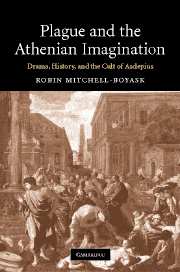Book contents
- Frontmatter
- Contents
- Preface
- Prologue
- Figure 1
- Chapter 1 Introduction
- Chapter 2 Death, myth and drama before the plague
- Chapter 3 Materials I: The language of disease in tragedy
- Chapter 4 Plague, cult and drama: Euripides' Hippolytus
- Chapter 5 Oedipus and the plague
- Chapter 6 The Trachiniae and the plague
- Chapter 7 Materials II: The cult of Asclepius and the Theater of Dionysus
- Chapter 8 Disease and stasis in Euripidean drama: Tragic pharmacology on the south slope of the Acropolis
- Chapter 9 The Athenian Asklepieion and the end of the Philoctetes
- Chapter 10 Conclusions and afterthoughts
- Works Cited
- Index
Chapter 7 - Materials II: The cult of Asclepius and the Theater of Dionysus
Published online by Cambridge University Press: 22 September 2009
- Frontmatter
- Contents
- Preface
- Prologue
- Figure 1
- Chapter 1 Introduction
- Chapter 2 Death, myth and drama before the plague
- Chapter 3 Materials I: The language of disease in tragedy
- Chapter 4 Plague, cult and drama: Euripides' Hippolytus
- Chapter 5 Oedipus and the plague
- Chapter 6 The Trachiniae and the plague
- Chapter 7 Materials II: The cult of Asclepius and the Theater of Dionysus
- Chapter 8 Disease and stasis in Euripidean drama: Tragic pharmacology on the south slope of the Acropolis
- Chapter 9 The Athenian Asklepieion and the end of the Philoctetes
- Chapter 10 Conclusions and afterthoughts
- Works Cited
- Index
Summary
Why should the Athenians, as a response to the waves of plague that struck their city during the first half of the 420s, have placed, six or seven years later, their new Asklepieion on the south slope of the Acropolis, as Figure 1 shows, below the Parthenon, the temple dedicated to Athena, and above the Theater, part of the sanctuary dedicated to Dionysus? Does Asclepius have some connection with drama, or was the shrine location purely coincidental? I have demonstrated that drama shows a persistent, though undeveloped, interest in disease imagery that becomes especially strong after the plague's onset, and this interest opens the door to the arrival of Asclepius near and in the Theater of Dionysus. The development of the cult of Asclepius in Athens and the range of myths involving him both associate him with Dionysus, the Greek god of, among other things, theater. Thus, on the levels of theme, ritual and performance Asclepius is important to Greek drama in the last quarter of the fifth century and beyond. Here I should make it clear, however, that I am not positing Asclepius as a god who appears as an overseer of the action in tragic plots, for he is far too benign and helpful a figure to play the same part as the more ambivalent gods Apollo and Dionysus.
- Type
- Chapter
- Information
- Plague and the Athenian ImaginationDrama, History, and the Cult of Asclepius, pp. 105 - 121Publisher: Cambridge University PressPrint publication year: 2007



